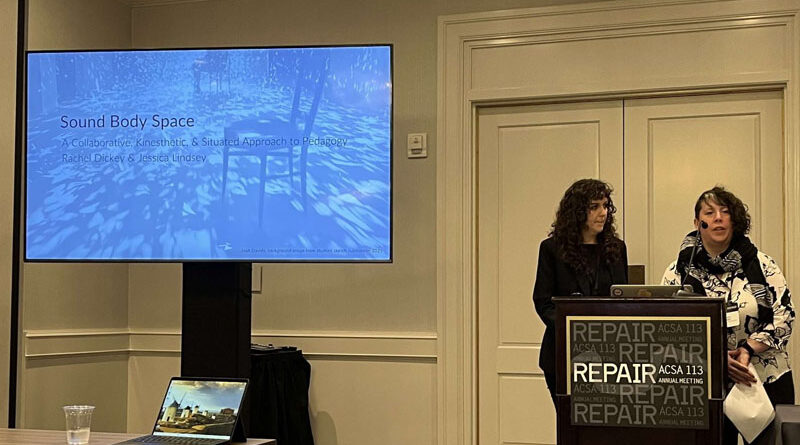Charlotte Professors Rachel Dickey And Jessica Lindsey Collaborate On “Sound, Body, And Space’ Seminar
Associate Professor of Architecture Rachel Dickey and Associate Professor of Music Jessica Lindsey have joined their research interests to co-teach the elective seminar “Sound, Body, and Space.” First taught in 2023 and offered again this semester, the course is open to all College of Arts + Architecture students and explores how experience-oriented design and performance are both enlivened, materialized, and situated in the world through the body.
The two professors recently presented a paper describing their course at the Association of Collegiate Schools of Architecture 113th Annual Meeting, held March 2-22 in New Orleans. The presentation, “Sound Body Space: A Collaborative, Kinesthetic, and Situated Approach to Pedagogy,” outlined their experiential pedagogy, through which students draw upon the power of observation and the creative use of imagination to explore how diverse bodies perceive sound in various spaces.
Noting the parallels between the experiences of being enveloped by music and by architecture, Lindsey and Dickey built the “Sound, Body, and Space” course curriculum around four core lessons:
- Start with self-awareness (with practices in spatial audio, kinesthetics, deep listening, and body-mind integration).
- Both knowledge and beauty are situated (produced from and within a certain context).
- The consideration of diverse experiences can enhance art and design.
- Leave the classroom (with field trips around campus and the city).
The curriculum is full of embodied learning and deep listening. During one class session, for example, they recreated Bernard Leitner’s exploration of spatial audio, using sound to define space by placing channeled speakers around an individual, who lies flat on the floor. (Pictured right.)
Furthermore, throughout the semester students visit a range of places on campus and off, “sensing the tactility of sound” in different spaces. Among their destinations this spring were city sites like Goodyear Arts at Camp North End, a former industrial complex, and First United Methodist Church, an uptown gothic revival sanctuary built in 1928.
“By observing, documenting, and responding to a range of experiences and spaces, the class provides a discursive tool for experience-generated art and design,” the professors wrote in their conference paper. “It offers moments for gaining conscious awareness to develop experience-related sensibilities.”
Dickey’s research is characterized by the synthesis of architecture, art, cognitive science, and technology to achieve a multifaceted study of the human experience and the built environment. Among her acoustic investigations is the “Sound Pavilion” (2020) installation, a gypsum architectural “instrument” that generated a unique auditory experience based on guests’ presence in and around it.
Lindsey is a clarinetist, a new music champion, and a member of the Spatial Forces Duo, a clarinet/bass clarinet that performs electroacoustic music. She is also a member of the Association for Body Mapping Education and a Licensed Body Mapping Educator.
The “Sound, Body, and Space” course was launched through a Pedagogical Innovation Award from the College of Arts + Architecture, encouraging interdisciplinary collaborative teaching.

